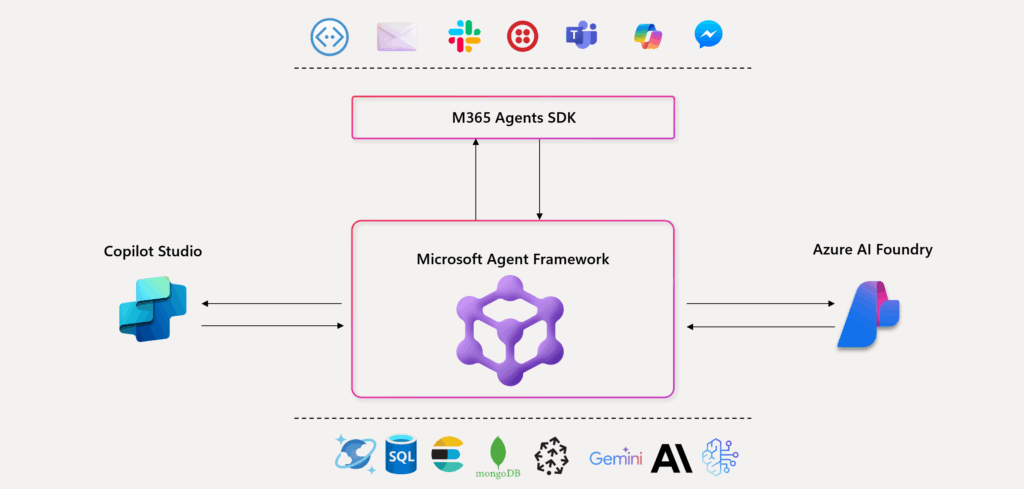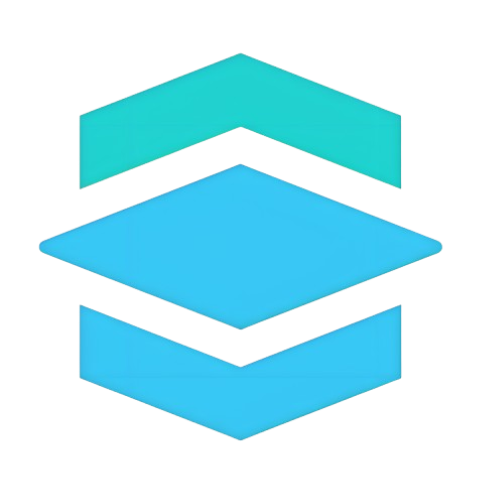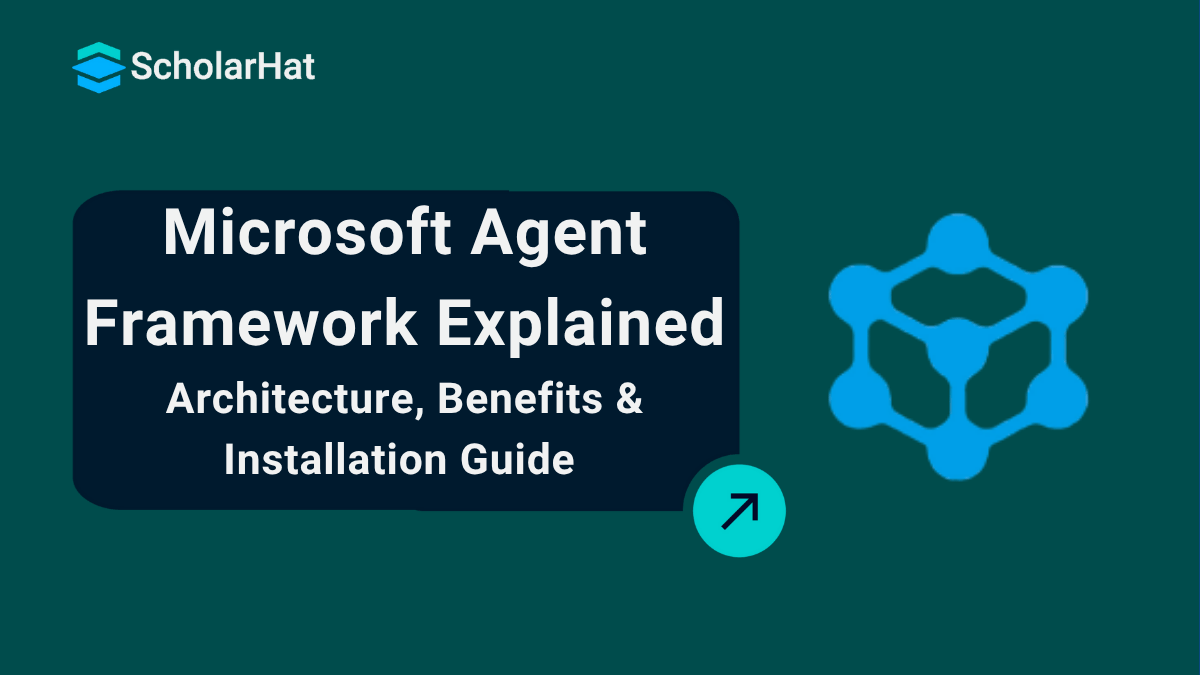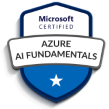21
NovMicrosoft Agent Framework Explained: Architecture, Benefits & Installation Guide
Microsoft Agent Framework is a powerful platform that helps developers create intelligent, autonomous AI agents capable of planning, reasoning, taking actions, and integrating with real-world tools and APIs. It provides ready-made building blocks like workflows, memory, and orchestration, making it easy to build secure and scalable AI systems within the Microsoft ecosystem.
In this tutorial, we’ll explore what the Microsoft Agent Framework is, key benefits, architecture overview, its core components, and real use cases. You’ll also learn how to install and set it up in both .NET and Python so you can start building your own AI agents with ease. And if you want to learn AI basics without any cost? Enroll in the Free Azure AI Fundamental Course and take the first step toward your AI career.
What is Microsoft Agent Framework?
Microsoft Agent Framework is a cutting-edge platform designed to help developers build intelligent, autonomous, and action-driven AI agents. These agents are capable of understanding natural language, breaking tasks into steps, reasoning through complex instructions, and interacting with external systems such as APIs, databases, and enterprise applications.
The framework simplifies the process of creating AI-powered workflows by providing prebuilt components like planners, memory systems, orchestrators, and tool integrations. Whether you’re building an internal automation bot, a customer support assistant, or a multi-agent collaborative system, the Microsoft Agent Framework gives you the architecture, scalability, and control needed to deploy enterprise-grade AI solutions with ease.

Why Choose Microsoft Agent Framework?
Here’s why developers choose it:
- It removes the complexity of building agentic logic from scratch.
- It offers native integrations with powerful LLMs (GPT-4o, Phi-3, Azure models).
- It ensures enterprise-level compliance, identity management, and monitoring.
- It works seamlessly across cloud, on-prem, and hybrid environments.
- It supports both Python and .NET developers with strong tooling support.
Benefits of Microsoft Agent Framework
- Enterprise-Grade Security & Compliance:Built with Microsoft’s security infrastructure, it supports authentication, governance, and access control out-of-the-box.
- Highly Modular Architecture: Developers can customize every part—agents, tools, memories, workflows—without breaking the system.
- Cross-Language Support (.NET & Python): Choose the language that fits your team for rapid prototyping and production deployment.
- Cloud-Native Scalability: Agents can run on Azure Functions, Kubernetes, or local machines with the same consistency.
- Enhanced Automation Capabilities: It enables agents to take autonomous actions, reducing manual workloads across operations, IT, development, and customer service.
- Integrated Developer Tools: First-class support for Visual Studio, VS Code, GitHub Actions, and Azure AI Studio makes the development cycle smoother.
Microsoft Agent Framework Architecture Overview
The Microsoft Agent Framework is designed to help developers build autonomous, intelligent AI agents that can reason, plan, act, and collaborate with other systems.

- Central Intelligence Layer: At the core, the framework hosts agents that perform reasoning, planning, and decision-making to execute tasks autonomously.
- Workflow & Orchestration Engine: Agents follow structured workflows that break complex tasks into smaller steps, ensuring organized and predictable execution.
- Memory & Context Management: The framework stores short-term and long-term context, allowing agents to remember past actions and adapt responses intelligently.
- Tool & API Integration Support: Agents can connect to external APIs, databases, CRMs, and automation tools, enabling real-world task execution and system interaction.
- Microsoft 365 Integrations: Through the M365 Agents SDK, agents can work inside Teams, Outlook, Loop, and other productivity apps to automate communication and workflows.
- Azure AI & Model Layer: The architecture connects seamlessly with Azure AI models for reasoning, text generation, summarization, and custom AI workflows.
- Data Source Connectivity: Agents can interact with SQL databases, Cosmos DB, Elastic, MongoDB, and vector stores to read, write, and analyze enterprise data.
- Low-Code Extensions via Copilot Studio: The framework integrates with Copilot Studio, allowing organizations to extend or customize agent behavior using low-code tools.
- Secure Deployment & Monitoring: Built-in security, logging, and monitoring ensure agents can run reliably at scale within enterprise environments.
Core Components: Agents, Workflows, and Building Blocks
1. Agents (The Intelligent Executors)
- Understand a user’s request using natural language processing.
- Break down a complex task into manageable steps.
- Decide which tools, APIs, or workflows to run.
- Learn from previous interactions using stored memory.
- Communicate with other agents to complete multi-step operations.
2. Workflows (The Execution Pipelines)
- Build multi-step automation pipelines.
- Combine decision-making logic with sequential/parallel tasks.
- Integrate external APIs, databases, and business logic.
- Add branching, conditional logic, and real-time responses.
- Automate repetitive processes with minimal coding
3. Building Blocks (Prebuilt AI Brains & Tools)
- Planner: Converts user objectives into executable task plans.
- Reasoner: Determines the next best actions based on context.
- Memory: Stores conversation history, task outputs, and long-term knowledge.
- Tools / Skills: Functions, scripts, APIs, or models the agent can use.
- Orchestrator: Manages workloads, agent collaboration, and execution flow.
Use Cases of Microsoft Agent Framework
1. Customer Support and Virtual Assistants
2. Intelligent Workflow Automation
3. Document Intelligence & Data Extraction
4. AIOps & IT Automation
5. Personalized Sales & Marketing Automation
6. Developer Assistance & Internal Tools
Getting Started: Installation and Setup for .NET and Python
The Microsoft Agent Framework is designed to be simple and accessible for all developers. Below are detailed steps to set up the environment.
.NET Installation & Setup
dotnet add package Microsoft.AgentFrameworkdotnet new agent
var agent = new Agent("assistant");
var result = await agent.RunAsync("Write a short note on Azure AI agents.");
Console.WriteLine(result);
- Database fetchers
- Email senders
- Web API clients
- File processors
Python Installation & Setup
pip install microsoft-agent-frameworkfrom agentframework import Agent
agent = Agent("assistant")
response = agent.run("Summarize the role of the Microsoft Agent Framework.")
print(response)- API calls
- Local functions
- Documents
- Database operations
- Multi-step workflows
- Locally on your machine
- In an Azure Function
- Inside a Docker container
- Through CI/CD pipelines
Conclusion
Take our Techtrends skill challenge to evaluate yourself!

In less than 5 minutes, with our skill challenge, you can identify your knowledge gaps and strengths in a given skill.








